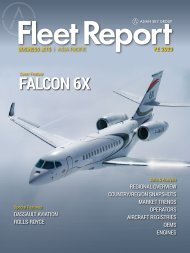Asia-Pacific AAM Report 1H 2023
You also want an ePaper? Increase the reach of your titles
YUMPU automatically turns print PDFs into web optimized ePapers that Google loves.
INTERVIEW WITH HONEYWELL<br />
It’s a great sandbox for building technologies like electric propulsion,”<br />
said Xu Jia, Chief Technology Officer, Honeywell UAM and UAS, in an<br />
interview with Global Sky Media, adding that Honeywell envisions a<br />
future of air taxis carrying people around the city and making a 100-<br />
mile commute in under 45 minutes.<br />
To unleash the economic and connectivity potential of advanced air<br />
mobility, Honeywell has a product line of electric motors as well as<br />
avionics and fly-by-wire systems. With both being an indispensable<br />
part for the integration of the operation system, electric propulsion<br />
is key to air taxis taking flight and an integral part of the whole new<br />
concept of eVTOLs.<br />
“Without distributed electric propulsion, eVTOLs wouldn't really exist as a<br />
concept. It's really at this technology inflection and the potential market<br />
demand that drove the development of this key technology,” Xu said.<br />
However, achieving the monumental technological breakthrough during<br />
the new journey calls for more than one player. Honeywell is working<br />
closely with companies including Lilium, DENSO, Archer and Supernal in<br />
developing electric motors and achieving specific goals like safety and<br />
noise, as well as optimizing the entire propulsion system.<br />
Honeywell formed a joint research program with vehicle engine<br />
manufacturer DENSO in 2019 and signed an alliance agreement<br />
to develop an electric propulsion system for eVTOLs in 2021. The<br />
engineers are working together on a daily basis to develop e-motors<br />
for the Lilium Jet.<br />
This is kind of a new opening<br />
space for aviation, a new way to<br />
democratize aviation, to make it<br />
pervasive and a different way to<br />
enter all of our lives.”<br />
To meet the requirements of each OEM, Xu said cooperation is<br />
always about communication and tradeoffs and finding the right<br />
optimization between the aircraft and the motor systems. For<br />
example, the unique configuration of the Lilium Jet needs as many<br />
as 36 small motors to achieve the aerodynamic performance<br />
required. While for more conventional lift plus crews and tilting rotor<br />
configurations, architects are working on bigger motors.<br />
vertically in a safe, efficient, and coherent manner.<br />
“It's one thing to build an electric motor for small drones or drone<br />
application, but when you want to build safe and certifiable electric<br />
motors at the scale that's needed to enable human or even cargo<br />
transportation over populated area, you very quickly get into some<br />
complex engineering problems and certification problems,” Xu explained.<br />
“One of the key challenges of vertical takeoff aircraft is we have<br />
very limited control authority at low speed right at high speed. The<br />
air is washing over the aircraft. We have a lot of energy in the air<br />
that we can play with to maneuver the aircraft at high speed, but at<br />
low speed when you're taking off, that's been really challenging,” Xu<br />
added, saying that Honeywell is building electric motors that have<br />
a smart level of redundancy on both the power electronic side, the<br />
control side as well as the active component of electric machines.<br />
For Honeywell, the “secret sauce” for building electric motors to achieve<br />
a high level of reliability is to ensure that the propulsion system still<br />
recovers and completes the flight if one of the motors fail. To achieve the<br />
safety and reliability goal, the architects divide the motor into numerous<br />
units that operate separately with the same amount of power. That said,<br />
the design has to be simple and light weight.<br />
The weight of eVTOLs is a fundamental factor to consider during<br />
aircraft construction, as it directly impacts the cost, with heavier<br />
models being more expensive. Studies show that each pound of<br />
empty weight costs around US$700 for aircraft acquisition. From<br />
the aircraft building side, even a slight change in weight can have a<br />
cascading effect, altering every aspect of aircraft design.<br />
“We understand the trade offs thatequip the tail with aircraft level,<br />
you know every pound that we put on an airplane in the form of a<br />
system, we have to build five more pounds of the aircraft right for<br />
these EV total platforms just because you put on this motor, the<br />
motor gets a little bit bigger. Now the whole aircraft gets a little bit<br />
bigger because we need more batteries to fly the same mission. The<br />
wing has to get bigger because we now have to sustain that flight,<br />
that cruise phase as well,” Xu said.<br />
Every Pound Matters: The Snowball Effect<br />
While working with the right partner helps, Honeywell’s most<br />
important task is to generate enough electric power to lift an aircraft<br />
<strong>1H</strong> <strong>2023</strong> ASIA-PACIFIC <strong>AAM</strong> REPORT | 87
















